
Glamis Castle is situated beside the village of Glamis in Angus, Scotland. It is the home of the Earl of Strathmore and Kinghorne, and is open to the public.

Blackness Castle is a 15th-century fortress, near the village of Blackness, Scotland, on the south shore of the Firth of Forth.

Doune Castle is a medieval stronghold near the village of Doune, in the Stirling district of central Scotland. The castle is sited on a wooded bend where the Ardoch Burn flows into the River Teith. It lies 8 miles (13 km) north-west of Stirling, where the Teith flows into the River Forth. Upstream, 8 miles (13 km) further north-west, the town of Callander lies at the edge of the Trossachs, on the fringe of the Scottish Highlands.
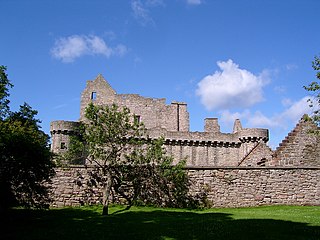
Craigmillar Castle is a ruined medieval castle in Edinburgh, Scotland. It is three miles (4.8 km) south-east of the city centre, on a low hill to the south of the modern suburb of Craigmillar. The Preston family of Craigmillar, the local feudal barons, began building the castle in the late 14th century and building works continued through the 15th and 16th centuries. In 1660, the castle was sold to Sir John Gilmour, Lord President of the Court of Session, who breathed new life into the aging castle. The Gilmours left Craigmillar in the 18th century, for a more modern residence nearby Inch House and the castle fell into ruin. It is now in the care of Historic Environment Scotland as a scheduled monument.
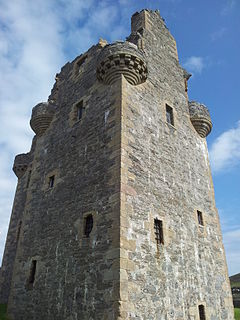
Scalloway Castle is a tower house in Scalloway, on the Shetland Mainland, the largest island in the Shetland Islands of Scotland. The tower was built in 1600 by Patrick Stewart, 2nd Earl of Orkney, during his brief period as de facto ruler of Shetland.

Tantallon Castle is a ruined mid-14th-century fortress, located 5 kilometres (3.1 mi) east of North Berwick, in East Lothian, Scotland. It sits atop a promontory opposite the Bass Rock, looking out onto the Firth of Forth. The last medieval curtain wall castle to be constructed in Scotland, Tantallon comprises a single wall blocking off the headland, with the other three sides naturally protected by sea cliffs.
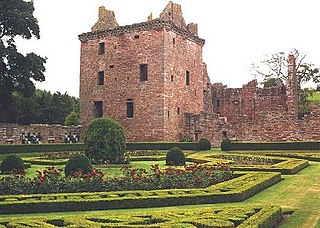
Edzell Castle is a ruined 16th-century castle, with an early-17th-century walled garden. It is located close to Edzell, and is around 5 miles (8 km) north of Brechin, in Angus, Scotland. Edzell Castle was begun around 1520 by David Lindsay, 9th Earl of Crawford, and expanded by his son, Sir David Lindsay, Lord Edzell, who also laid out the garden in 1604. The castle saw little military action, and was, in its design, construction and use, more of a country house than a defensive structure. It was briefly occupied by English troops during Oliver Cromwell's invasion of Scotland in 1651. In 1715 it was sold by the Lindsay family, and eventually came into the ownership of the Earl of Dalhousie. It was given into state care in the 1930s, and is now a visitor attraction run by Historic Environment Scotland. The castle consists of the original tower house and building ranges around a courtyard. The adjacent Renaissance walled garden, incorporating intricate relief carvings, is unique in Scotland. It was replanted in the 1930s, and is considered to have links to esoteric traditions, including Rosicrucianism and Freemasonry.

Edinample Castle is a late 16th-century tower house on the southern shores of Loch Earn near Balquhidder in the Stirling council area of Scotland. It was designated as a Category A listed building in 1971.

Muchalls Castle stands overlooking the North Sea in the countryside of Kincardine and Mearns, Aberdeenshire, Scotland. The lower course is a well preserved Romanesque, double-groined 13th century towerhouse structure, built by the Frasers of Muchalls. Upon this structure, the 17th-century castle was begun by Alexander Burnett of Leys and completed by his son, Sir Thomas Burnett, 1st Baronet, in 1627. The Burnetts of Leys built the remaining four storey present day castle.
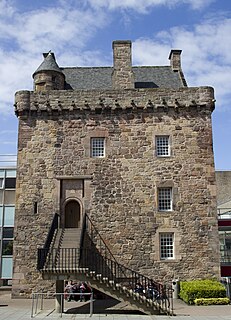
Merchiston Tower, also known as Merchiston Castle, was probably built by Alexander Napier, the 2nd Laird of Merchiston around 1454. It serves as the seat for Clan Napier. It was the home of John Napier, the 8th Laird of Merchiston and the inventor of logarithms, who was born there in 1550.

Lauriston Castle is a 16th-century tower house with 19th-century extensions overlooking the Firth of Forth, in Edinburgh, Scotland. It lies on Cramond Road South, between Cramond, Davidson's Mains, and Silverknowes. The substantial grounds, Lauriston Castle Gardens, operate as a local park. The castle was bequeathed to the Edinburgh Corporation and hosts the Lord Provost's annual Garden Party. The house is a Category A listed building and the grounds are included in the Inventory of Gardens and Designed Landscapes in Scotland.
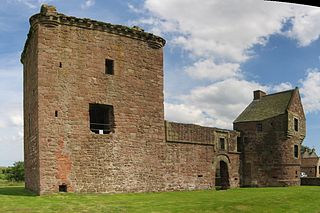
The remains of Burleigh Castle are located just outside the village of Milnathort, 1.5 miles north of Kinross, in Perth and Kinross, Scotland. The castle dates from the 15th and 16th centuries, and now sits beside the A911 road, opposite a 19th-century steading, recently adapted into housing.
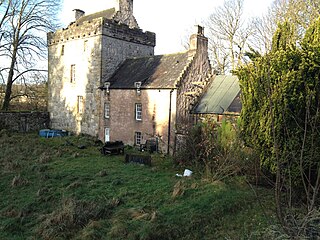
Castle Cary Castle is a fifteenth-century tower house, about 6 miles (10 km) from Falkirk, in the former county of Stirlingshire, Scotland. It is less than 3 miles from Cumbernauld Village. It is located near to the site of one of the principal forts of the Roman Antonine Wall.
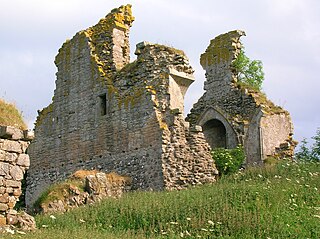
Craigie Castle, in the old Barony of Craigie, is a ruined fortification situated about 4 miles (6.4 km) southeast of Kilmarnock and 1 mile (1.6 km) southeast of Craigie village, in the Civil Parish of Craigie, South Ayrshire, Scotland. The castle is recognised as one of the earliest buildings in the county. It lies about 1.25 miles (2 km) west-south-west of Craigie church. Craigie Castle is protected as a scheduled monument.
Ardblair Castle is an L-plan castle, dating from the 16th century, around 0.75 miles (1.21 km) west of Blairgowrie in Perth and Kinross, Scotland.
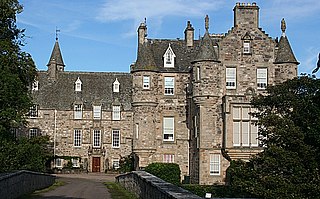
Cullen House is a large house, now divided into fourteen separate dwellings, about 1 kilometre (0.6 mi) south west of the coastal town of Cullen in Moray, Scotland. Originally built between 1600 and 1602, incorporating some of the fabric of a medieval building on the site, it was the seat of the Ogilvies of Findlater, who went on to become the Earls of Findlater and Seafield, and remained in their family until 1982. The house has been extended and remodelled several times since 1602, by prominent architects such as William Adam, his sons James and John Adam, and David Bryce. It has been described by the architectural historian Charles McKean as "one of the grandest houses in Scotland".
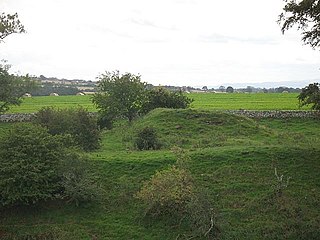
Billie Castle is a ruined 15th century quadrangular castle, 3 miles (4.8 km) north west of Chirnside, Scottish Borders, Scotland, north of Billiemains. It was designated as a scheduled monument in 1988.

Patrick Lyon, 1st Earl of Kinghorne was a Scottish landowner.

Rusco Tower, sometimes called Rusco Castle, is a tower house near Gatehouse of Fleet in Dumfries and Galloway, Scotland. Built around 1500 for Mariota Carson and her husband Robert Gordon, on lands given to them by her father, it was used to incarcerate a number of the Gordons' rivals in the 16th century. After Robert Gordon died and Carson remarried, their eldest son James Gordon seized the tower and imprisoned his mother, fearing that she would make it over to her new husband, Thomas Maclellan of Bombie. Gordon went on to kill Maclellan on the High Street in Edinburgh, while a court case intended to settle the matter was ongoing.
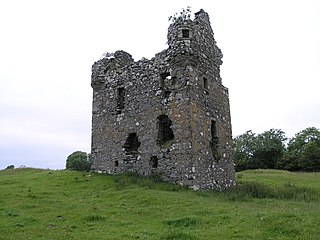
Plunton Castle is a ruined L-plan tower house near between Kirkandrews and Gatehouse of Fleet in Dumfries and Galloway, Scotland. Built around 1575 for the Lennoxes of Plunton, it passed by marriage to the Murrays of Broughton in the late 17th century. It was still inhabited in 1684, when it is described in Reverend Symson's Large Description of Galloway as 'a good strong house', but by 1838, when it was painted by George Colomb, it had been abandoned and had fallen into a ruinous condition.



















